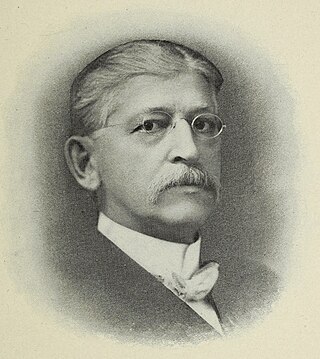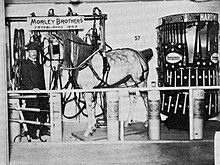
Bay City is a city in and the county seat of Bay County, Michigan, United States. The population was 32,661 at the 2020 census. The city is located just upriver from Saginaw Bay on the Saginaw River. It is the principal city of the Bay City metropolitan area, which is coterminous with Bay County as part of the larger Greater Tri-Cities region of Central Michigan. Several historic bridges cross the Saginaw River in Bay City, including Liberty Bridge, Veterans Memorial Bridge, Independence Bridge, and Lafayette Avenue Bridge.

Saginaw is a city in and the seat of Saginaw County, Michigan, United States. The city proper had a population of 44,202 at the 2020 census. Located along the Saginaw River, Saginaw is adjacent to Saginaw Charter Township and considered part of Greater Tri-Cities region of Central Michigan. The Saginaw metropolitan area had a population of 190,124 in 2020. The city is also the largest municipality in the Greater Tri-Cities, with a combined population of 377,474 in the combined statistical area in 2020.

Aaron Thomas Bliss was an American politician who served as a U.S. Representative and the 25th governor of Michigan, and was from Saginaw. Bliss Township was named after him.

The Flint Journal is a quad-weekly newspaper based in Flint, Michigan, owned by Booth Newspapers, a subsidiary of Advance Publications. Published Tuesdays, Thursdays, Fridays and Sundays, it serves Genesee, Lapeer and Shiawassee Counties. As of February 2, 2012, it is headquartered in Downtown Flint at 540 S Saginaw St, Suite 504. The paper and its sister publications The Saginaw News and The Bay City Times are printed at the Booth-owned Valley Publishing Co. printing plant in Monitor Township.
MLive Media Group, originally known as Booth Newspapers, or Booth Michigan, is a media group that produces newspapers in the state of Michigan. Founded by George Gough Booth with his two brothers, Booth Newspapers was sold to Advance Publications, a Samuel I. Newhouse property, in 1976.

Central Michigan, also called Mid Michigan, is a region in the Lower Peninsula of the U.S. state of Michigan. As its name implies, it is the middle area of the Lower Peninsula. Lower Michigan is said to resemble a mitten, and Mid Michigan corresponds roughly to the thumb and palm, stretching from Michigan's eastern shoreline along Lake Huron into the fertile rolling plains of the Michigan Basin. The region contains cities of moderate size, including Flint, Saginaw, and the state capital of Lansing. Generally Central, or "Mid", Michigan is defined by governmental organizations as an area North of Jackson, and South of Clare.

William Seelye Linton was an American businessman and politician who served two terms in the U.S. House of Representatives from Michigan from 1893 to 1897.
Sewell Lee Avery (November 4, 1874 – October 31, 1960) was an American businessman who achieved early prominence in gypsum mining and became president of the United States Gypsum Company (1905–1936). At the beginning of the Depression, he was asked by J.P. Morgan & Co. to turn around the failing Montgomery Ward and succeeded in restoring its profitability by making huge changes. In 1936, Fortune magazine said that Avery was "generally held to be the No. 1 Chicago businessman." In the postwar years, however, he failed to take advantage of the demand for durable goods and did not expand Montgomery Ward, costing it prominence in the retail field.

Fashion Square Mall is an enclosed shopping mall located in the northern edge of Saginaw Charter Township, Michigan. It lies within the boundaries of M-84 to the west, Tittabawassee Road to the north, Fashion Square Blvd. to the east, and Schust Road to the south. The mall serves the city of Saginaw, its suburbs, and the greater Great Lakes Bay Region. It features more than 100 tenants, including a food court, and its anchor stores are JCPenney and Macy's.
The Detroit, Lansing and Northern Railroad (DL&N) is a defunct railroad which was formed on December 27, 1876 as a reorganization of the foreclosed Detroit, Lansing and Lake Michigan Rail Road. The segment of its main line from Detroit to Lansing became an important component of the Pere Marquette Railroad, organized in 1900, and is still in use by CSX.

Oliver Moulton Hyde was a Detroit businessman, manufacturer, and politician who was elected mayor of Detroit three times, in 1854, 1856, and 1857.

Bay City Town Center is an enclosed shopping mall in Bangor Township, Bay County, Michigan, just outside the city of Bay City, Michigan, United States. Opened in 1991, the mall features Dunham's Sports, Marshalls, Ollie's Bargain Outlet, and PetSmart, with vacancies previously occupied by Younkers, JCPenney, and Target. The mall also features a 10-screen movie theater owned by Goodrich Quality Theaters. It is managed by a partnership of Lormax Stern. It is the second mall in Bay County, Michigan, the first being the defunct Hampton Square Mall.
Hamady was an American supermarket chain based in Flint, Michigan, United States, which at its peak had 37 stores and 1,300 employees. Given the chain's pervasiveness in the area, paper grocery bags were known as “Hamady sacks”.

The Wright Opera House Block, also known as the Alma Opera House Block, is a commercial block located at 101–113 East Superior Street and 408 North State Street in Alma, Michigan. It was listed on the National Register of Historic Places in 2013.

Hampton Towne Centre, formerly Hampton Square Mall, was an enclosed shopping mall in Hampton Township, Michigan, just outside the city of Essexville, Michigan, United States. Built in 1975, the property became a dead mall following the closure of its anchor stores, and ultimately closed in 2010. The building, vacant except for a thrift store, an intermediate school district, and a Michigan Department of Human Services office, was owned by Art Dore who died November 2 of 2022.

Saginaw Future Inc. is a private nonprofit economic development organization that encourages investments in Saginaw, Michigan. It is an Accredited Economic Development Organization (AEDO) by the International Economic Development Council (IEDC). While the organization is private, it is primarily funded by area governments.

William Q. Atwood was a lumber baron in Saginaw, Michigan. Born a slave in Alabama, he was freed in 1853 in the will of his white master and father, and moved to the free state of Ohio. He became active in the Underground Railroad in Ripley, Ohio. During the American Civil War, Atwood moved to the northwest, settling in East Saginaw, Michigan in 1863. There he became successful in real estate and lumber dealing.

Nelson Ludington was a nineteenth-century American businessman, lumber baron and banker. Born in Ludingtonville, New York, he made his fortune in the Midwest based on resource exploitation: lumber, iron ore and copper.

George Woodward Hotchkiss was an American nineteenth-century businessman and journalist who wrote about the lumber industry. He was co-founder and editor of several newspapers, including what the Journal of Forest History has considered to be North America's first lumber newspaper, Lumberman's Gazette. He contributed to the publication of a manual on the timber trade, which sold 40,000 copies. In 1898 he published the book History of the Lumber and Forest Industry of the Northwest. In the view of one 1920s author, Hotchkiss was the "father" of lumber periodicals.
Wickes Companies was a diversified manufacturing and retail conglomerate. It renamed itself after its subsidiary Collins & Aikman in 1992. The company ceased operations in 2007.


















